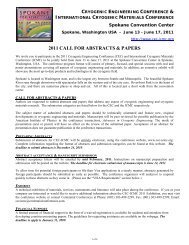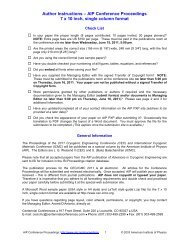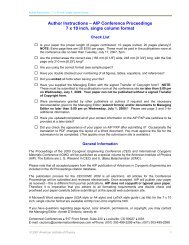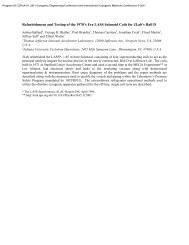CEC Abstracts in PDF format (as of 7/3/07) - CEC-ICMC 2013
CEC Abstracts in PDF format (as of 7/3/07) - CEC-ICMC 2013
CEC Abstracts in PDF format (as of 7/3/07) - CEC-ICMC 2013
You also want an ePaper? Increase the reach of your titles
YUMPU automatically turns print PDFs into web optimized ePapers that Google loves.
<strong>CEC</strong> 20<strong>07</strong> - <strong>Abstracts</strong><br />
Double-<strong>in</strong>let is a key factor for a double-<strong>in</strong>let type pulse tube<br />
refrigerators. It is important to understand the characters <strong>of</strong> double<strong>in</strong>let.<br />
Deep research on characters <strong>of</strong> double-<strong>in</strong>let will be very helpful<br />
to reveal the mechanics <strong>of</strong> pulse tube refrigerator.<br />
This work is supported by Natural Sciences Foundation <strong>of</strong> Ch<strong>in</strong>a<br />
(50206025).<br />
C1-D-03 Experimental Studies on a Two-Stage Pulse<br />
Tube Cryocooler Reach<strong>in</strong>g 3.3 K<br />
S. K<strong>as</strong>thurirengan, G. Sr<strong>in</strong>iv<strong>as</strong>a, G.S. Karthik, Centre<br />
for Cryogenic Technology, Dept. <strong>of</strong> Physics, Indian<br />
Institute <strong>of</strong> Science; K.P. Ramesh, Dept. <strong>of</strong> Physics,<br />
Indian Institute <strong>of</strong> Science; K.A. Shafi, TKM College<br />
<strong>of</strong> Eng<strong>in</strong>eer<strong>in</strong>g, Kollam, Kerala, India.<br />
A two stage Pulse Tube Cryocooler is designed and fabricated, which<br />
reaches no load temperatures <strong>of</strong> 3.3 K <strong>in</strong> the second stage and ~60 K<br />
<strong>in</strong> the first stage respectively. The system provides a refrigeration<br />
power <strong>of</strong> ~ 250mW at 5 K <strong>in</strong> the second stage. Sta<strong>in</strong>less steel meshes<br />
(size 200) and lead (Pb) granules are used <strong>as</strong> first stage regenerator<br />
materials and comb<strong>in</strong>ations <strong>of</strong> Pb with Er3Ni or Pb with HoCu2 are<br />
used <strong>as</strong> second stage regenerator materials. The system operates at 1.8<br />
Hz us<strong>in</strong>g an <strong>in</strong>digenous rotary valve along with a 6 kW water-cooled<br />
Helium compressor.<br />
Studies conducted by vary<strong>in</strong>g the dimensions <strong>of</strong> Pulse Tubes and<br />
regenerators for the first and second stages show that pulse tube<br />
dimensions are more critical to the performance <strong>of</strong> the Cryocooler<br />
than those <strong>of</strong> the regenerators. Experimental studies show that the<br />
optimum volume ratio <strong>of</strong> Pb to Er3Ni or HoCu2 (<strong>in</strong> the second stage)<br />
should be ~ 3:2 for the best performance <strong>of</strong> the Cryocooler. Further,<br />
systems with HoCu2 performed better than those with Er3Ni. Pulse<br />
Tube Cryocoolers performed better when operated with anti-parallel<br />
double <strong>in</strong>let valves than when operated with other DC flow<br />
arrangements.<br />
Theoretical analysis <strong>of</strong> the above two-stage Pulse Tube Cryocooler<br />
system h<strong>as</strong> been carried out us<strong>in</strong>g a simple isothermal model. The<br />
experimentally me<strong>as</strong>ured cool<strong>in</strong>g powers are <strong>in</strong> close agreement with<br />
the theoretical predictions.<br />
F<strong>in</strong>ancial support for the study h<strong>as</strong> come from the Council <strong>of</strong><br />
Scientific and Industrial Research, New Delhi, India.<br />
C1-D-04 A buffered rotary valve system <strong>of</strong> GM-type<br />
pulse tube refrigerator<br />
G. Hwang, J. Jung, S. Jeong, KAIST.<br />
In a GM or a GM-type PTR (Pulse Tube Refrigerator), considerable<br />
amount <strong>of</strong> helium flow is produced dur<strong>in</strong>g the pressure transition<br />
periods from high to low values or vice versa. In a conventional rotary<br />
valve system, however, this k<strong>in</strong>d <strong>of</strong> helium <strong>in</strong>- and out-flow which are<br />
supplied directly from the helium compressor does not contribute to<br />
the actual refrigeration power. We devised a buffered rotary valve<br />
system <strong>in</strong> order to reduce such an unnecessary helium flow from the<br />
compressor. In a buffered rotary valve system, pressuriz<strong>in</strong>g and<br />
depressuriz<strong>in</strong>g flow is not solely supplied by the compressor but also<br />
provided by a buffer volume. Theoretically, half <strong>of</strong> the transition flow<br />
can be alleviated <strong>in</strong> the compressor with a s<strong>in</strong>gle buffer. The aim <strong>of</strong><br />
the buffered rotary valve system is to use a compressor more<br />
effectively and make the expansion process <strong>in</strong> PTR more efficient. In<br />
this paper, the buffered rotary valve system is <strong>in</strong>troduced at the first<br />
time, fully described with simple thermodynamic analysis, and also<br />
<strong>in</strong>vestigated experimentally to show its performance <strong>in</strong>cre<strong>as</strong>e.<br />
This research w<strong>as</strong> supported by a grant from Center for Applied<br />
Superconductivity Technology <strong>of</strong> the 21st Century Frontier R&D<br />
Program funded by the M<strong>in</strong>istry <strong>of</strong> Science and Technology, Republic<br />
<strong>of</strong> Korea.<br />
C1-D-05 An experimental study <strong>of</strong> the G-M type two-<br />
Stage Pulse Tube Cryocooler for cryopump<br />
S.J. Park, Y.J. Hong, H.B. Kim, Korea Institute <strong>of</strong><br />
Mach<strong>in</strong>ery & Materials; S.J. Lee, Hyunm<strong>in</strong><br />
Laboratory.<br />
The pulse tube cryocooler, which h<strong>as</strong> no mov<strong>in</strong>g parts at its cold<br />
section, is attractive <strong>in</strong> obta<strong>in</strong><strong>in</strong>g higher reliability, simpler<br />
construction, and lower vibration than any other small cryocoolers.<br />
Korea Institute <strong>of</strong> Mach<strong>in</strong>ery & Materials(KIMM) h<strong>as</strong> developed G-<br />
M type and Stirl<strong>in</strong>g type pulse tube cryocooler s<strong>in</strong>ce 1992. The<br />
developments <strong>in</strong> KIMM on the pulse tube cryocooler systems have<br />
focused primarily on refrigeration capacity, efficiency and<br />
performance reliability <strong>as</strong> well <strong>as</strong> mechanical reliability. The purpose<br />
<strong>of</strong> this study is to provide reliable, efficient and long life cryocoolers<br />
for cool<strong>in</strong>g systems <strong>in</strong> cryopump and other applications. The G-M<br />
type two-stage pulse tube cryocooler consists <strong>of</strong> a helium compressor,<br />
a pulse tube, regenerator, orifice, double <strong>in</strong>let valve, a buffer<br />
(reservoir) volume and vacuum chamber. This paper describes the<br />
two-stage pulse tube cryocoolers designed for cool<strong>in</strong>g arrays <strong>of</strong> the<br />
cryopump and their performance characteristics.<br />
C1-D-06 Optimization <strong>of</strong> two stage pulse tube<br />
refrigerator for the <strong>in</strong>tegrated current lead system<br />
R. Maekawa, S. Takami, A. Okada, T. Mito, National<br />
Institute for Fusion Science; Y. Matsubara, KEK; M.<br />
Konno, Fuji Electric Systems Co.; A. Tomioka, Fuji<br />
Electric Advanced Technology Co.; T. Imayoshi, H.<br />
Hay<strong>as</strong>hi, Kyusyu Electric Power Co..<br />
The <strong>in</strong>tegrated current lead system, consists <strong>of</strong> a copper lead, a High<br />
Temperature Superconductor and two stage pulse tube refrigerator,<br />
h<strong>as</strong> been developed for Superconduct<strong>in</strong>g Magnetic Energy Storage<br />
(SMES) system. A two-stage pulse tube refrigerator, series connected<br />
arrangement, w<strong>as</strong> designed to satisfy the requirements for the<br />
<strong>in</strong>tegrated current lead system. Operation <strong>of</strong> the first stage<br />
refrigerator is four-valve method, while the second stage utilizes a<br />
double <strong>in</strong>let method. This arrangement ensures the compactness <strong>of</strong><br />
the current lead system. Refrigeration process <strong>of</strong> two-stage pulse tube<br />
refrigerator h<strong>as</strong> been <strong>in</strong>vestigated to validate the conceptual design<br />
and f<strong>in</strong>alize the current lead system development.<br />
This work is supported by the NEDO under the contract <strong>of</strong><br />
"Superconduct<strong>in</strong>g Power Network Control Technology Development"<br />
and by NIFS under ULAA114. The authors wish to acknowlege H.<br />
Ohkubo at Suzuki Shokan Co. for his support.<br />
C1-D-<strong>07</strong> Damp<strong>in</strong>g <strong>of</strong> Intr<strong>in</strong>sic Temperature Oscillations<br />
<strong>in</strong> a 4 K Pulse Tube Cooler<br />
by Means <strong>of</strong> Rare Earth Plates<br />
G. Thummes, L.M. Qiu, M. Dietrich, K. Allwe<strong>in</strong>s,<br />
University <strong>of</strong> Giessen.<br />
Regenerative cryocoolers, such <strong>as</strong> GM-coolers and pulse tube coolers,<br />
show oscillations <strong>of</strong> the refrigeration temperature that result from the<br />
periodic expansion <strong>of</strong> the work<strong>in</strong>g fluid (helium). In c<strong>as</strong>e <strong>of</strong> cryogenfree<br />
operation <strong>of</strong> sensitive superconduct<strong>in</strong>g devices the temperature<br />
oscillations can be rather disturb<strong>in</strong>g because <strong>of</strong> the <strong>as</strong>sociated<br />
variation <strong>of</strong> the critical current and gap voltage. The oscillations can<br />
be damped by <strong>in</strong>cre<strong>as</strong><strong>in</strong>g the thermal m<strong>as</strong>s attached to the cold end <strong>of</strong><br />
the cooler. For cool<strong>in</strong>g near 4 K it is impractical to employ normal<br />
metals for this purpose <strong>as</strong> <strong>in</strong> this c<strong>as</strong>e the specific heat <strong>of</strong> helium<br />
greatly exceeds that <strong>of</strong> normal metals. Here we report on the damp<strong>in</strong>g<br />
<strong>of</strong> temperature oscillations by mak<strong>in</strong>g use <strong>of</strong> the high specific heat <strong>of</strong><br />
rare-earth alloys, such <strong>as</strong> ErNi. Tests were performed on two types <strong>of</strong><br />
<strong>in</strong>-house made 4 K pulse tube coolers with <strong>in</strong>put powers <strong>of</strong> 6 kW and<br />
1.7 kW. The damp<strong>in</strong>g is accomplished by ErNi-plates <strong>of</strong> different<br />
thickness that were <strong>in</strong>stalled between the cold end <strong>of</strong> the 4 K stage<br />
and the device mount<strong>in</strong>g platform. E.g., with a 3.6 mm thick ErNiplate<br />
(m<strong>as</strong>s: 55 g) the temperature oscillation at 3.5 K w<strong>as</strong> reduced by<br />
a factor <strong>of</strong> 18 from 90 mK to 5 mK <strong>in</strong> the 1.7 kW-system. The thermal<br />
resistance <strong>of</strong> the plate w<strong>as</strong> 9 K/W, which w<strong>as</strong> sufficiently low to<br />
successfully operate an AC Josephson voltage standard near 4 K by<br />
this set-up.<br />
This work h<strong>as</strong> been supported <strong>in</strong> part by the German BMBF (FKZ<br />
13N8410). L.M. Qiu (permanent address: Zhejiang University,<br />
Hangzhou 310027, P.R. Ch<strong>in</strong>a) thanks the DAAD for a fellowship.<br />
Page 4 <strong>of</strong> 53






